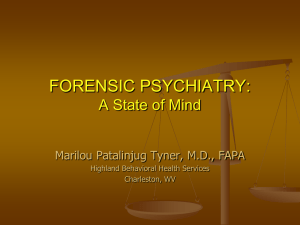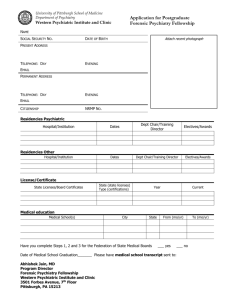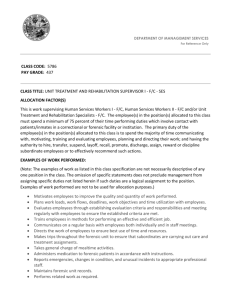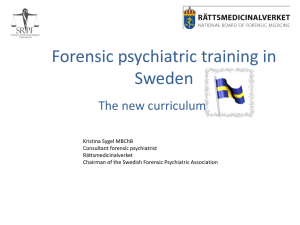FORENSIC PSYCHIATRY COMMONWEALTH PROFFESSIONAL
advertisement
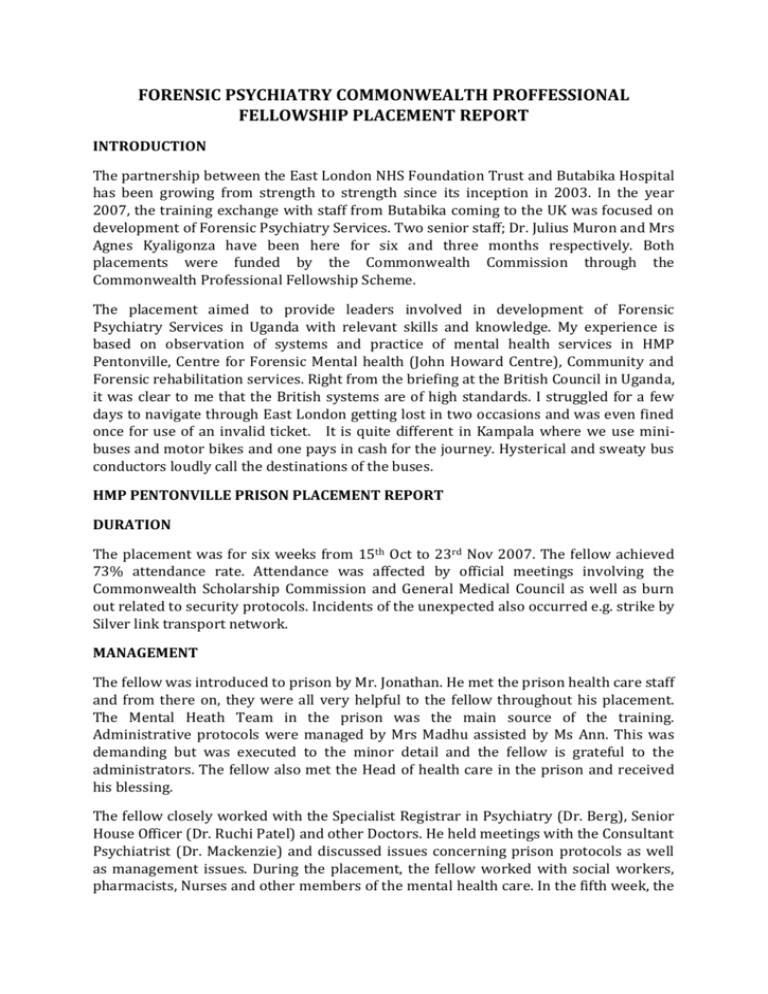
FORENSIC PSYCHIATRY COMMONWEALTH PROFFESSIONAL FELLOWSHIP PLACEMENT REPORT INTRODUCTION The partnership between the East London NHS Foundation Trust and Butabika Hospital has been growing from strength to strength since its inception in 2003. In the year 2007, the training exchange with staff from Butabika coming to the UK was focused on development of Forensic Psychiatry Services. Two senior staff; Dr. Julius Muron and Mrs Agnes Kyaligonza have been here for six and three months respectively. Both placements were funded by the Commonwealth Commission through the Commonwealth Professional Fellowship Scheme. The placement aimed to provide leaders involved in development of Forensic Psychiatry Services in Uganda with relevant skills and knowledge. My experience is based on observation of systems and practice of mental health services in HMP Pentonville, Centre for Forensic Mental health (John Howard Centre), Community and Forensic rehabilitation services. Right from the briefing at the British Council in Uganda, it was clear to me that the British systems are of high standards. I struggled for a few days to navigate through East London getting lost in two occasions and was even fined once for use of an invalid ticket. It is quite different in Kampala where we use minibuses and motor bikes and one pays in cash for the journey. Hysterical and sweaty bus conductors loudly call the destinations of the buses. HMP PENTONVILLE PRISON PLACEMENT REPORT DURATION The placement was for six weeks from 15th Oct to 23rd Nov 2007. The fellow achieved 73% attendance rate. Attendance was affected by official meetings involving the Commonwealth Scholarship Commission and General Medical Council as well as burn out related to security protocols. Incidents of the unexpected also occurred e.g. strike by Silver link transport network. MANAGEMENT The fellow was introduced to prison by Mr. Jonathan. He met the prison health care staff and from there on, they were all very helpful to the fellow throughout his placement. The Mental Heath Team in the prison was the main source of the training. Administrative protocols were managed by Mrs Madhu assisted by Ms Ann. This was demanding but was executed to the minor detail and the fellow is grateful to the administrators. The fellow also met the Head of health care in the prison and received his blessing. The fellow closely worked with the Specialist Registrar in Psychiatry (Dr. Berg), Senior House Officer (Dr. Ruchi Patel) and other Doctors. He held meetings with the Consultant Psychiatrist (Dr. Mackenzie) and discussed issues concerning prison protocols as well as management issues. During the placement, the fellow worked with social workers, pharmacists, Nurses and other members of the mental health care. In the fifth week, the fellow had experience with CARATS (Drug and Alcohol rehabilitation services in the prison). While at CARATS, the fellow was supported by the CARATS lead administrator (Mr. Daniel) and was given practice protocols and operational manuals. ACTIVITIES i) ii) iii) iv) v) vi) vii) Joint assessments of prisoners; admitted to health care (with SpR, SHO), referred to MHT from the prison wings (with social workers), and those who need drug rehab (with CARATS social workers). Responding to immediate needs of patients in the health care and regular review of prisoners in a 16 bedded Health care (SpR, SHO, Nurses). Management rounds (with Consultant Psychiatrist, SpR, SHO, Social workers, nurses) were patients in health care and those seen in outpatients are discussed one by one. Format used to write out management round list was impressive and it contained; lists of patients, their needs, legal status, planned interventions and persons responsible for those interventions. Observation and learning use of Mental Health Act Sect 48, 47, 38, 37, 36 and prison practice protocols. Interacted with other prison services e.g. Chaplaincy, Independent Monitoring Board, security, cleaners, recreation, sport, day care unit, use of library, group therapy and observed how these contributed to rehabilitation of sick prisoners. Observed management of clinical records (EMIS data system, prescription charts, and administrative documents), administration of medications and methods of communication (Fax, telephone and face to face verbal). Attended two SHO teachings; conference on case of sexual abuse in childhood and adult borderline personality focussing on management challenges and a case of ‘mentalisation’ as means of group therapy for patients with personality disorders in an inpatient personality unit (North London). ACHIEVEMENT OF EXPECTED OBJECTIVES The following objectives were comprehensively achieved; 1. 2. 3. 4. Experience with 16 bedded health care -based on daily activities. Observation of assessment of new prisoners –based on daily activities. Health promotion in the prison. Observed Psychiatry in-reach team and consultations provided by Forensic Psychiatrists from medium secure units. It was through this mechanism that prisoners get admitted to hospital; either to a Medium Secure unit or general Psychiatry unit. During this period, only one prisoner was admitted to a high security hospital. Management of disturbed behaviour and engagement with disturbed prisoners was observed. De-escalation and close nursing observation of prisoners at risk were central to the care of disturbed prisoners. Deliberate self harm and risk of suicide were the common disturbed behaviours with very minor cases of violence at the health centre. Cases were brought from the prison wings with history of physical violence after management at segregation. ACCT was the protocol used for observation and recording disturbed behaviour. There was no use of physical restraint and rapid tranquilisation used as their need was limited. I did not have a chance to witness incident review and debriefing as none occurred during this period. The fellow learnt use of UK MHA 1983 and common law applicable prison psychiatry practice. Upon review of the Uganda Mental Health Treatment Act (MHA) 1964, I sighted sections 3, sect 5 and sect 21 to be equivalence of sections 35-38, 47-48 used in the UK. The fellow experienced use of atypical antipsychotics and Zopiclon. There was often uncommon to respond to medication side effects as these occurred only rarely. The medication dosages were often at the lower end of BNF recommendations. Whenever patients with perceived capacity to refuse medications refused to take any medication, they would not be forced to take medication in prison instead they waited for admission to hospital for any medication to be started. Use of occupational assessment was not structured in prison and often relied on verbal reports of how one interacted and performed during an activity. PLACEMENT WITH NORTH EAST LONDON FORENSIC SERICES (Dr, G. Waldron’s team) PSYCHIATRY Objectives of this placement were to observe the assessment, and management of mentally disordered offenders both in inpatient and community settings. The placement was for four weeks and it was the first placement in a Medium Secure Unit (John Howard Centre). ACHIEVED A four hour security induction was conducted to highlight the structural and procedural security measures applicable at a medium secure unit. I was introduced to the staff of the team and was given a weekly program. I participated in ward rounds which provided the opportunity to appreciate the use of Mental Health Act 1983, understanding issues about leave, evaluation of patients for medication side effects and efficacy of medications used. I observed the use of atypical antipsychotics and Clozapine, participated in providing information to patients about drugs used and consenting to treatment. I also witnessed management of patients under seclusion and use of behavioral methods to manage violence in the PICU. The use of alarms, radio calls and function of the rapid response team was appreciated. Talking down patients and close observation limited the use of physical restraint. Violent patients were often reviewed in the presence of the physical restraint team even when talking down was successful in the previous review until when such a patient becomes stable in behavior. The liaison between Forensic Psychiatry and General Psychiatry services were observed. This provided a link for referrals to be made, allowed for the Forensic Psychiatry team to work with CMHT and AOT in the community. The Forensic Psychiatry team was involved in assessment and management planning (CPA) for community treated patients with Forensic Psychiatry needs; i.e. high risk of violence and patients on part III MHA 1983 restrictions. I attended a CPA meeting at Camlet lodge on a case of transfer from acute ward of Medium secure unit to low security rehabilitation setting. During this placement, I held discussions with the consultant on matters such as; use of MHA 1983 in Forensic setting including Sect 136 and 17, forensic aspects of fire setting, stalking and fitness to stand trial. I had access to journals of forensic psychiatry to supplement the discussions. Academic seminars provided for opportunity to discuss management of challenging cases as well as service development issues. An opinion journal article in Psychiatric Bulletin 2008 discussing the limitations of Medium Secure Unit services was reviewed. It highlighted need for continued innovations to respond to the limitations of the services set up. Also case discussions on ; (i) sexual offending, i.e. incest, domestic violence, zoophile and child protection issues and (ii) a case of challenging behavior with changing paranoid personality and polydypsia associated with severe hyponatreamia (27 mmol/L) were the other top of the list challenging cases discussed.. PLACEMENT WITH FORENSIC PSYCHIATRY SERVICES OF EAST LONDON (Dr. J. Berman’s team at London Borough of Newham) The objectives of the placement were to observe the assessment and management of mentally disordered offenders in the inpatient and community setting. Major ward rounds and assessment of referrals were the major learning activities. This placement was for four weeks. ACHIEVED I observed weekly ward rounds in acute ward (Ludgate) and long stay (Lime house). The ward rounds involved presentation of multi-disciplinary team reports, review of issues about escorted and unescorted leave, medication review and monitoring medication side effects, discussion of plans for discharge including legal procedures, accommodation, education, employment and finances. I attended multiple Care Program Approach meetings demonstrating; team work, involvement of patients in care planning, working with patients legal representatives and working with community mental health teams in planning discharge. Regular weekly community forensic psychiatry team meetings were held to promote team work, validation of decisions by the team members and role allocation. I attended a tribunal hearing and appreciated the constitution of the tribunal, its role, documentation involved, patient representation and tribunal process. The Tribunal aimed to promote patients dignity and rights. It balanced legal and moral judgment based on presence of mental disorder of the nature and severity, patient’s needs, treat ability and prognosis of mental health problem. Court diversion involved police or GP making referrals of offenders suspected to have mental problems to a mental health worker. The mental health worker then makes a brief assessment and makes a report to court indicating issues about fitness to stand trial, the need for admission of the offender for assessment (Sect 35 or 3 MHA 1983), or treatment to hospital and coordination of such an admission. I participated in court assessment and admission process of elderly offender to a old adult ward. The decision about the level of security needed to assess or treat the offender determined the hospital were the offender would be admitted. If the offender is known to mental health services, his community mental health team would be contacted to plan his care. I attended the monthly Multiagency Public Protection Panel (MAPPA) meetings and experienced team work involved in MAPPA care planning. I appreciated the role of a mental health representative in the MAPPA meetings. These included; reporting on mental health issues that may negate safety, Identifying needs for Psychiatry assessment and making referrals. Other members of this team were; housing managers, child protection officers, and probation and prison officers. PLACEMENT IN FORENSIC REHABILITATION SERVICES Forensic rehabilitation services provided opportunity to experience the contribution of Psychiatry interventions to recovery and advancement of skills, knowledge and attitudes of patients. These interventions were in relation to the mental health needs, offending behaviour and planning reintegration of patients to the community. The rehabilitation services observed were organised around a low secure unit within a hospital setting (Tuke Ward), low secure unit in the community (Tariro house) and various levels of supported accommodations (Hostels). Patients in the rehabilitation units (Tuke Ward) typically had minimal psychotic disturbance, the environment was homely and patients had responsibility to manage the environment. The patients had a say on how the ward was managed and addressed the managers directly during the ward community meetings. These provided a high level of accountability from staff as well as patients behaviour. Most of the patients also had unescorted leave; they used it to go to study, shop, leisure, work or visit relatives. Some patients had weekend leave to stay in the community based hostels as part of their progress to discharge. Most clients had a time table of activities to be carried out during the course of the week. These activities also included attending therapeutic groups; either within Centre for Forensic Health or in the day care centres in the community. Use of standardised tools for assessment of level of function such as CASIG, were witnessed. Monitoring medication side effects and treatment of physical conditions were integral part of rehabilitation care. Patients were given all necessary information to promote their mental health. Tariro house was a 16 bedded low secure unit in the community and it provided for 24 hour nursing care to all patients on daily basis. The unit demonstrated a partnership between private and NHS service delivery. It had a complete Psychiatry team, all of whom were from the NHS except the nursing staff and occupational therapist who were directly employed by the private health provider. Most of the clients had unescorted leave and the daily duration of leave depended on the patient’s needs. Several therapeutic groups were available, and I participated in sharing solutions and current affairs groups. This unit functioned more or less like a ward. The patients applied to the Tribunal for discharge and were given either absolute discharge or more commonly conditional discharge. The conditions included restriction orders (Section 41/49 of MHA 1983), no go zones, appropriate housing, Random Urine checks and extra. After the low secure units, patients who progressed in care, moved on to live in supported accommodation. There were various types of supported accommodation (hostels); hostels were clients lived completely independent of other clients in the hostel and those hostels were clients had common meals, recreation and support from wardens to meet activities of daily living. Wardens help the clients to manage medications, monitor client’s ability to perform activities of daily leaving and help them to access rehabilitation services in the community. The wardens reported issues of concern to the Psychiatry team and the Multiagency Public Protection Panel meetings. The Forensic Psychiatry Team supported the Community Mental Health teams (CMHT) for the first six months after discharge of Forensic cases. A joint CPA would be held during that period before the care is handed over to the CMHT. Forensic Community Psychiatry Nurse provided daily psychiatry care in the community and coordinated the CPA. During this period, I witnessed the relapse of self harming behaviour of a patient who over the last 20 years had progressed from high security hospital (Broadmoore) to low secure rehabilitation unit. This patient had schizoaffective disorder but predominantly with antisocial personality disorder. He had poor compliance with medication, limited engagement with rehabilitation services and was actively erotomanic towards female nurses who had previously nursed him. After this patient attempted suicide by over dose of chlorpromazine, he was readmitted in the Psychiatry Intensive Care Unit. The Consultant Rehabilitation Psychiatrist of Tuke ward provided the fellow with learning materials as well as Library materials for Butabika Forensic Psychiatry Library. The placement achieved its overall aim of exposing the fellow to a range of Forensic Psychiatry Rehabilitation Services. PLACEMENT IN COMMUNITY FORENSIC PSYCHIATRY SERVICES The objectives of the placement were; to observe mental health assessments at the police stations, and during court diversions, to participate in ward rounds, care planning and visiting of clients in their homes. I visited a range of Community Forensic Psychiatry Services (CMHT) and the services were organised with Community Mental Health teams playing a central role in continued care of Forensic cases. Forensic Psychiatry teams liaised with CMHT at the time of planning patients discharge and during the first six months to one year after discharge. Continued participation of Forensic teams was particularly needed in care of patients discharged with restriction orders and those managed under Multiagency Public Protection Panel. A Forensic Psychiatry Community Psychiatry Nurse (CPN) provided care to clients in their homes, reported to the Forensic team and coordinated the Care Programme Approach (CPA) meetings. Each CPN had a client load of 15-20 patients at any one time. Other members of the team visited patients in their homes depending on their needs. Primary health care trust team members provided the treatment for physical conditions. Special housing arrangements exist between local councils and NHS trusts to accommodate discharged Forensic patients. Patients moved from acute wards of a Medium Secure Unit (JHC) to a highly supported accommodation and finally to independent living in hostels or flats. It was exciting to be hosted to a cup of tea prepared by clients in their hostel and witnessed how those clients worked as a team in the residence. The wardens in the hostels helped the clients with activities of daily living whenever they needed such help and also supervised medications. Rehabilitation of Forensic cases in the community occurred in any Psychiatry rehabilitation services in the locality. These services included; day care centres, leisure centres, education facilities and employment. Other specialised teams in the community such as drug and alcohol team treated discharged patients and those referred from the court diversion scheme. Both the CMHT and the wardens reported to the probation officers on matters concerning patients on restriction orders and those released on parole. Such issues could include; use of illicit drugs, random urine checks, breach of no go zones, violence, compliance with medications, and any other worrying behaviour. Such reports would be discussed during Multiagency Public Protection Panel. Breach of restrictions and relapse of Psychiatry morbidity were common reasons for recall of patients released on licence. After this placement, I had a chance to visit general Psychiatry services at Mile End Hospital (Global Ward) and Homerton Hospital (Bavern, Joshua wards). The patients in those wards were more acutely disturbed than the Forensic cases seen at JHC. The teams were stretched by the patients’ diverse needs, there was increased use of PRN medication (haloperidol and benzodiazepines) and the dosages were higher than those used at JHC. At Mile End Hospital, it was nice to see how female and male patients shared a common room of the ward. Patients in both Forensic and General Psychiatry were of diverse origin, mostly African and Asian origin. The commonest diagnosis was schizophrenia (Probably 70% and over). During this period, I made a presentation to JHC audience on nature of Forensic Psychiatry Services available in Uganda and interventions we have planned to start when we return back to Uganda. The presentation was well attended and it stimulated a discussion and some staff indicated that they would be interested in coming over to Uganda to support the development of new interventions. CONCLUSION The HMP Pentonville prison experience provided the fellow with a foundation of skills and knowledge upon which he will be able to model the prison mental health services in Uganda. Some of the practices observed here are directly transferable while the labour intensive and expensive strategies may need to be modified. Other reforms will need preliminary work with the Ministry of Health, Ministry of Internal Affairs and Directorate of Prison Health Services of Uganda. The experience attained from the JHC placement will provide knowledge and skills to make realistic changes in our care of Forensic cases in Uganda. Details of the developments are as contained in the power point presentation here attached. ADMINSTRATION OF THE FELLOWSHIP The candidate selection and travel arrangements were smoothly organized. For this the Commonwealth Commission, British Council and East London NHS Foundation Trust deserve an excellent score. The predeparture briefing and the flash disc organized by the British Council were very helpful. Meeting the Commonwealth Alumni in Uganda was not only lovely but also inspiring. I was particularly thrilled and challenged by the achievements and the profile of the Commonwealth Commissioners I met during the events in the UK. The host organization arrangement to receive the Fellow at the airport provided a kind and calming reception. The first dinner in the UK is memorable and it straight away took some convincing for me to accept that tap water was safe to drink right away. The host organization had also arranged for hostel accommodation and I initially did not like it for its shared amenities. It took two weeks to adjust and things then started operating smoothly. The payment of stipend was timely and convenient. Solitary life, discovering opportunity to network and making new friends took some time. Commonwealth events were the first real place I met people both from Uganda and other parts of the world who liked charting out. Mail networking then started and to date I have contact to friends in Malawi, Bangladesh, Guyana. Later, I was able to make friends in a pub where I used to go to watch football. Friends of Butabika link were also important networks through which I went out to their homes for Sunday Dinners and also went to watch Arsenal Football at Emirates Stadium. Going to church was the most refreshing way to start a new week. Christmas (2007) found me here and it provided opportunity to learn something different and enjoy while far away from my family. Tuning to BBC radio channels provided both entertainment and current affairs. Listening to talk shows has enabled me to appreciate level of public opinion and know commonly used English words. I am looking forward to my last few days in the UK and hopefully a fascinating enjoyable flight back to Uganda without any bad memories about Heathrow. My experience will begin to influence formal and informal interactions as soon as I return to Uganda. I will keep you up dated if you flag up your interest on juliusmuron@yahoo.co.uk
